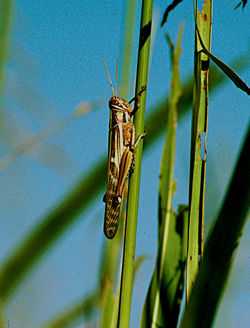Kosher locust
| Kosher locust | |
|---|---|

A red locust. | |
| Halakhic texts relating to this article: | |
| Torah: | Leviticus 11:22 |
| Mishnah: | Chullin 59a |
| Babylonian Talmud: | Chullin 65a-66b and Avodah Zarah 37a |
| Shulchan Aruch: | Yoreh De'ah 85 |
| Other rabbinic codes: | Exodus Rabbah 13:7 |
| * Not meant as a definitive ruling. Some observances may be rabbinical, custom or Torah-based. | |
Kosher locusts are varieties of locusts that are deemed permissible for consumption under the laws of kashrut (Jewish dietary law). While the consumption of most insects is considered to be forbidden under the laws of kashrut, the rabbis of the Talmud identified eight kosher species of locusts. However, the identity of those species is in dispute.[1]
Source in the Torah
The Torah states in Parshat Shemini:"Every flying insect that uses four legs for walking shall be avoided by you. The only flying insects with four walking legs you may eat are those with knees extending above their feet, [using these longer legs] to hop on the ground. Among these you may only eat members of the red locust family, the yellow locust family, the spotted gray locust family and the white locust family. All other flying insects with four feet [for walking] must be avoided by you."[2]
Sources in the Talmud
Tractate Chullin 59a, 65a-66b and Tractate Avodah Zarah 37a
The Mishna states in Chullin 59a:"Any kind of grasshopper that has four walking legs, four wings, two jumping legs and whose wings cover the greater part of its body is kosher."
Yemenite tradition
According to Yemenite tradition the four types of kosher locust in the Torah are:
- The red locust (Hebrew: ארבה, Arbeh, Aramaic: גובאי, Govei, Arabic: الجراد, Al-Jaraad).
- The spotted gray locust (Hebrew: חרגול, Chargol Aramaic: ניפול, Nippul, Arabic: الحرجوان, Al-Harjawaan).
- The white locust (Hebrew: חגב, Chagav, Aramaic: גדיאן, Gadayin, Arabic: الجندب, Al-Jundub).
- The yellow locust (Hebrew: סלעם, Sal'am, Aramaic: רשון, Rashona, Arabic: الدبا, Al-Daba).
Djerba tradition
In the Jewish community of Djerba in Tunisia, the consumption of locusts was forbidden by a takkanah of rabbi Aron Perez mid-18th century. The implication therefore is that they were regularly consumed in that community at that time.[3]
Normative practice
The Halachah regarding locusts, and all Kosher animals for that matter,[citation needed] is that one is allowed to eat a specific type of animal only if there is a "continuous tradition", also known as a "mesora", that affirms that it is Kosher. It is not enough that the locust seems to conform to the criteria mentioned in the Torah. This does not mean that one must possess a 'personal tradition' in order to eat locusts. If one travels to a place where the people do have a tradition, the new arrival would also be allowed to eat them. The Yemenite Jews and some others had such a continuous tradition.
It is also worth pointing out that the common names used in the Bible refer only to color and broad morphological generalities shared by a huge number of Middle Eastern species. Also, although it is often useful for identification, the geographic location of these locusts in the text is unclear. Using primarily color to identify insect species is a notoriously unreliable approach. Insects that come to adulthood will have slightly different colors based on season, diet, and prevailing climate. Which species of locust are actually being referred to in the text is therefore nearly impossible to ascertain. This will further complicate adherence.
British Chief Rabbi Joseph Hertz says in his commentary on Leviticus 11:22
"None of the four kinds of locust mentioned is certainly known (RV Margin). For this reason also, later Jewish authorities, realizing that it is impossible to avoid errors being made declare every species of locust to be forbidden." [4]This opinion is the one generally held by Ashkenazi Jews.[citation needed]
Jews who live in consonance with ritual laws normally consult a rabbi when questions on ritual practices arise.
How and by whom Kosher locusts were eaten
The author of the Aruch Hashulchan points out that locusts were not considered a delicacy—rather they were food for the poor.
The Midrash in Shemot Rabba hints that one way to eat locusts was to pickle them:
"Once the locusts came, the Egyptians rejoiced and said 'Let us gather them and fill our barrels with them.' Hakadosh Baruch Hu (a name of God, literally meaning: "The Holy One, Blessed be He") said 'Wicked people, with the plague that I have brought against you, are you going to rejoice?!' Immediately God brought upon them a western wind ... and none were left. What does it mean that none were left? Even those that were pickled with salt and sitting in their pots and barrels were blown away...."
In the New Testament, the itinerant prophet John the Baptist is said to have lived in the desert and eaten "locusts and wild honey" (Matthew 3:4, Mark 1:6). As a forerunner of Jesus, John would have kept the Kosher laws as understood in his day.
References
- ↑ Abramowitz, Jack. "Knee-High to a Grasshopper: The obligation to examine locusts for signs of being kosher". OU.org. Retrieved March 20, 2013.
- ↑ Leviticus 11:20-23
- ↑ Valensi, Lucette; Udovitch, Abraham L. (1984). Juifs en terre d'islam : les communautés de Djerba. p. 18. ISBN 2-903928-05-3. Unknown parameter
|éditeur=ignored (help) - ↑ Hertz, Rabbi Dr. J.H. (1960). Soncino Press (London), ed. 'Pentateuch and Haftorahs: Hebrew Text, English Translation and Commentary. p. 451, note on v. 22. ISBN 0-900689-21-8.
External links
- Laws of Judaism concerning insects From the Torah and Maimonides’ Code of Jewish Law